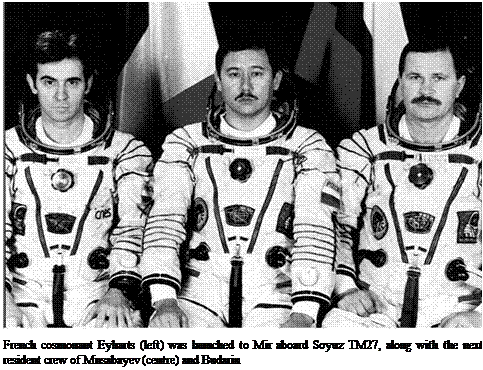. SOYUZ TM27
Flight Crew
MUSABAYEV, Talgat Amangeldyevich, 47, Russian Air Force, commander, 2nd mission
Previous mission: Soyuz TM19 (1994)
BUDARIN, Nikolai Mikhailovich, 44, civilian, flight engineer, 2nd mission Previous mission: Mir EO-19 (STS-71/Soyuz TM21) (1995)
EYHARTS, Leopold, 40, French Air Force, cosmonaut researcher
Flight Log
The original Pegasus mission had been scheduled for August 1997, but the collision of Progress with Mir and the subsequent on-orbit difficulties meant that the flight was delayed. There was also a medical issue, with Jean-Pierre Haignere having injured his leg during a badminton match in July 1997. He was replaced by Eyharts, but as a result, the French mission was moved back to the next Soyuz TM flight. The Pegasus science programme was a repeat of that completed by Claudie Andre-Deshays in 1996 under the Cassiopee programme. Eyharts was kept fully occupied during his three weeks on the station, returning with the EO-24 crew on 19 February.
The EO-25 crew now settled down to work with Thomas, the final American resident on Mir, as well as completing the routine maintenance and housekeeping chores all Mir resident crews had to address. The EO-25 crew also completed a programme of six EVAs. The first, on 3 March (1 hour 15 minutes), had to be abandoned when a hatch wrench broke, preventing them from opening the exit. With replacement parts delivered by Progress M38, the two cosmonauts resumed their EVA work in April, delaying their science programme by completing five excursions in the same month (1 Apr for 6 hours 26 minutes; 6 Apr for 4 hours 23 minutes; 11 Apr for 6 hours 25 minutes; 17 Apr for 6 hours 33 minutes; and 22 Apr for 6 hours 21 minutes). Their work included bracing the solar array that had been damaged by the Progress

collision. As it was still generating some electricity, the Russians wanted to try to repair the solar array rather than disabling it. They also replaced the VDU engine block and stowed the Rapana Truss next to the Sofora girder (for possible future use). During the EVAs, Thomas assisted the EVA crew from inside the space station.
The cosmonauts resumed their science programme after completing their month of EVAs. NASA was pushing for the demise of Mir to allow full concentration on the ISS programme, but Russia was reluctant to do so. With existing contracts to fly one more long French mission and a Slovak visiting mission, there were also reports of selling seats to fare-paying passengers for short missions, generating much needed funds for the programme. This idea of “Soyuz seats for sale” generated interest from wealthy individuals across the world, and led to the prospect of turning Mir into a commercially funded station while ISS was under construction. This did not go down well with the Americans, who basically wanted Mir out of the way so that everyone’s full attention could be devoted to the more complex work on ISS. A shortage of hardware and funds was already a familiar and concerning problem in operations at Mir, and the Americans did not want to see a drain on resources from ISS because the Russians were trying to run two space station programmes. For the Russians, however, it was also a question of national pride. They wanted to keep their Mir station in orbit as long as they could.
In June, STS-91 arrived to bring home American astronaut Andy Thomas and so end two years of continuous US occupation of Mir. Among the Shuttle crew was
veteran Russian cosmonaut Valery Ryumin, now chief of the Russian side of the Shuttle-Mir programme. His primary role on the mission was to make a thorough inspection of the Mir complex to assess its potential for further use. He concluded that it would take some time to stow everything properly and that a crew of two or three cosmonauts would struggle to keep on top of the tasks. What Mir needed was a crew of six or seven to fully utilise the station. This was not something NASA wanted to hear.
After STS-91 had departed, Musabayev commented that the station was far roomier now there were only two on board. The cosmonauts resumed their science work with materials-smelting experiments, Earth observations and remote sensing, and continued the biological and medical experiment programmes. In August 1998 a new crew arrived at Mir, just three months before the start of ISS construction.
Milestones
205th manned space flight 86th Russian manned space flight 79th manned Soyuz mission 26th manned Soyuz TM mission 25th Mir resident mission
32nd Russian and 70th flight with EVA operations 5th French long-duration mission (21 days)










